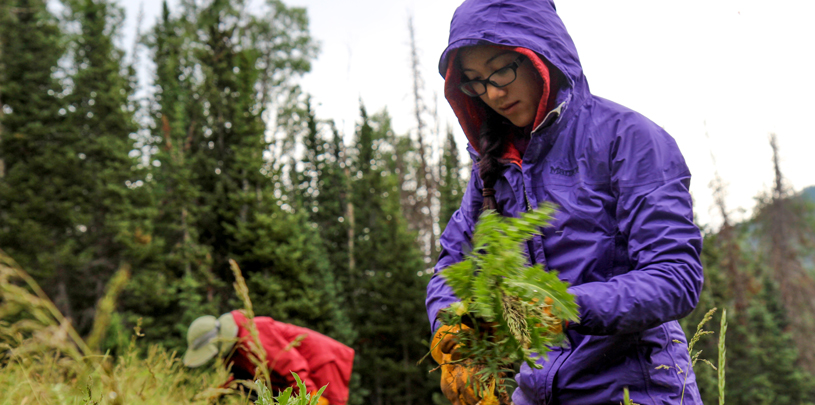
 by Lisa Winters, Research and Stewardship Volunteer Coordinator
by Lisa Winters, Research and Stewardship Volunteer Coordinator
We’re excited to announce our 2018 volunteer trip schedule: from pulling invasive plants to collecting habitat data for endangered fish, we’ve got something for everyone. Find the trip that’s the best fit for you, and roll up your sleeves for conservation this summer.
Favoritism disclaimer: As the citizen science coordinator here at the Grand Canyon Trust, I’ve been excitedly looking forward to all this season’s trips since we put them on the calendar.
Fact-check disclaimer: Please note that these are not the real categories for the Academy Awards. Also, these awards do not reflect the opinion of the Grand Canyon Trust. Send in your trip application if you want to lodge a complaint with me.
 Best trip for animal-lovers
Best trip for animal-lovers
Pronghorn are the second-fastest land mammal on earth, but they don’t jump. Confronted with a barbed-wire fence, they crawl underneath. We’ll spend a weekend helping pronghorn movement by replacing barbed wire fencing with a smooth wire higher off the ground. Leave feeling inspired that you’ve helped this quick-footed species get where it’s going, minus the barbs. Sign me up ›
 Best trip for hikers
Best trip for hikers
Stream surveys are part of a long-term effort to map trends in how water flows on the surface as part of the Four Forest Restoration Initiative. Last year we spent three full days hiking over 45 miles through the rugged Mogollon Rim, following streams across meadows and through the ponderosa pine forest to collect information on where water is located. This year, we’re going back to see what has changed. Sign me up ›
 Best trip for citizen scientists
Best trip for citizen scientists
Channel your inner geomorphologist and observe stream channels in a whole new way. We’re exploring the streams of the Mogollon Rim this week to identify habitat for a tiny endangered fish, the Little Colorado Spinedace. We’ll measure stream flow, channel depth, channel width, and generally get our feet wet as we collect detailed data to help inform a recovery plan for this struggling species. Sign me up ›
 Best trip for grazing reform advocates
Best trip for grazing reform advocates 
The impacts of poor grazing practices can be seen on nearly every habitat, plant community, food web, soil type, and species in southern Utah. Join us as we learn to document livestock damage across public lands. Practice photography, identify exotic grasses, describe different types of impacts, and leave feeling empowered to speak up for grazing reform. Sign me up ›
 Best short trip
Best short trip 
During this quick weekend trip, we’ll give you the training you need to do your own independent citizen science and advocacy work after the trip is over. We’ll teach you how to describe livestock impacts, document via photographs, and collect information on basic native and invasive grasses. We’ll visit a small area of northern Arizona, with the hope that you will explore and document more on your own after the trip is done. Sign me up ›
 Best director in a (trip) leading role
Best director in a (trip) leading role  Mary O’Brien, spring restoration at Grand Staircase-Escalante National Monument, August 20- 24, 2018
Mary O’Brien, spring restoration at Grand Staircase-Escalante National Monument, August 20- 24, 2018Springs — diverse, rare, and threatened places — are some of the most cherished and culturally significant areas in the Southwest. Join our all-star Utah Forests Program Director, Mary O’Brien, as we explore both the history and ecology of springs. Sign me up ›
 Best associate in a (trip) supporting role
Best associate in a (trip) supporting role  Marc Coles-Ritchie, spring surveys at Bears Ears National Monument, June 19-23, 2018
Marc Coles-Ritchie, spring surveys at Bears Ears National Monument, June 19-23, 2018Utah Forests Program Associate Marc emerged on the Grand Canyon Trust scene last year and proved to be indispensable in teaching botany and sharing ecological wisdom with everyone. Join him to survey springs around Bears Ears National Monument and get ready for a fun, productive, and life-changing week. Your plant ID, observation, and GPS skills will benefit. Sign me up ›
 Best original production
Best original production 
Set up camp in the beautiful Johnson Lakes Canyon, next to the lake and tucked in among the towering rock walls of Grand Staircase-Escalante National Monument, and help collect data and document native plant recovery as part of restoring the 840 wild, diverse, and overgrazed acres of an inholding held by Rick and Susie Knezevich. You’ll be well taken care of as you work, learn, and play with like-minded conservation heroes. Sign me up ›
We’re still looking for nominees in the “best volunteer in a leading role” category, so protect the places that you love and spend a week (or weekend) out on the land with us this summer. Check out our 2018 volunteer trips ›
As 2024 draws to a close, we look back at five maps we created this year that give us hope for 2025.
Read MoreThe federal government will determine if the charismatic blue bird should be listed as threatened or endangered.
Read MoreWe can’t wait to meet you in a canyon, along a creek, or in the high alpine meadows of the Colorado Plateau.
Read More